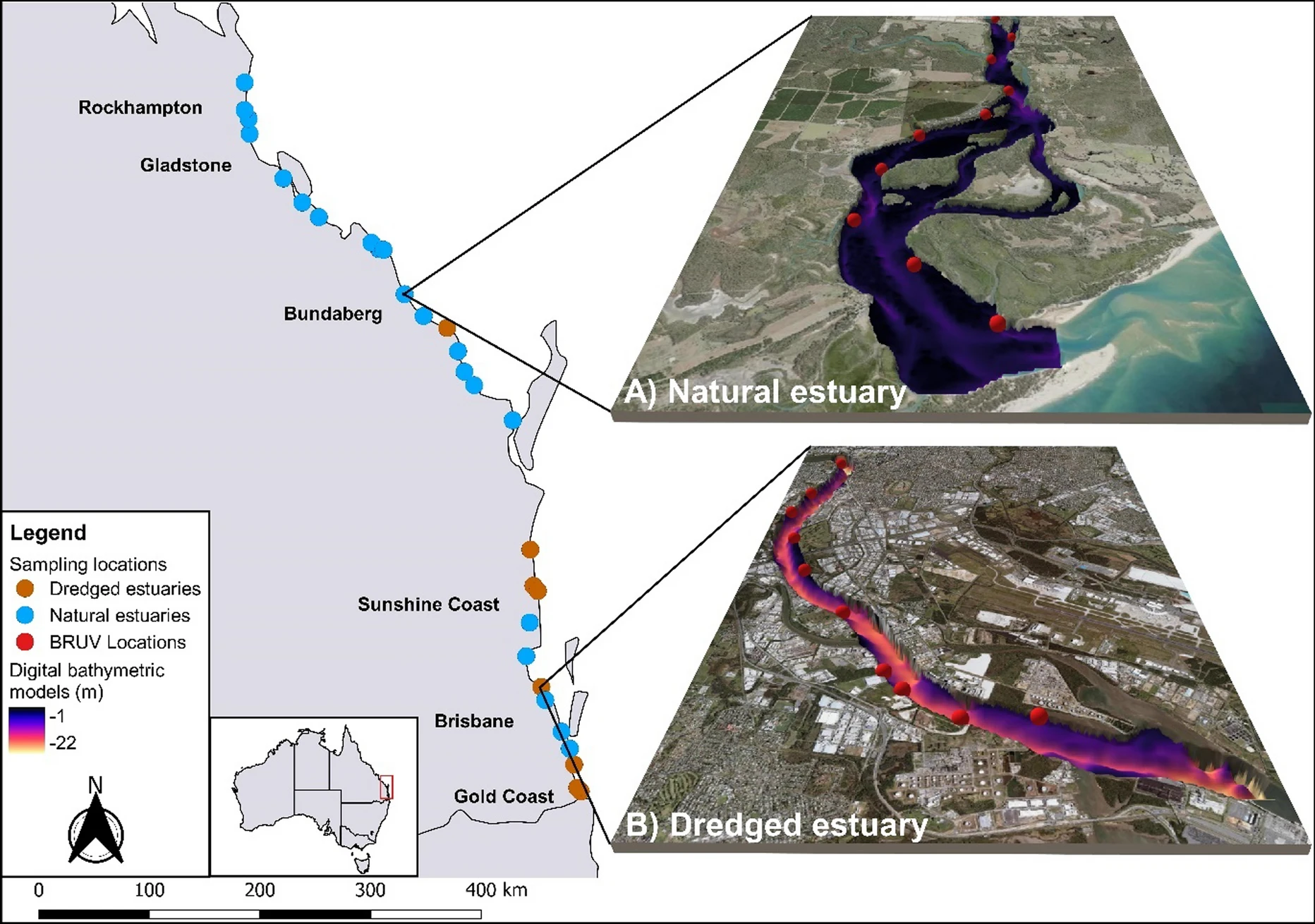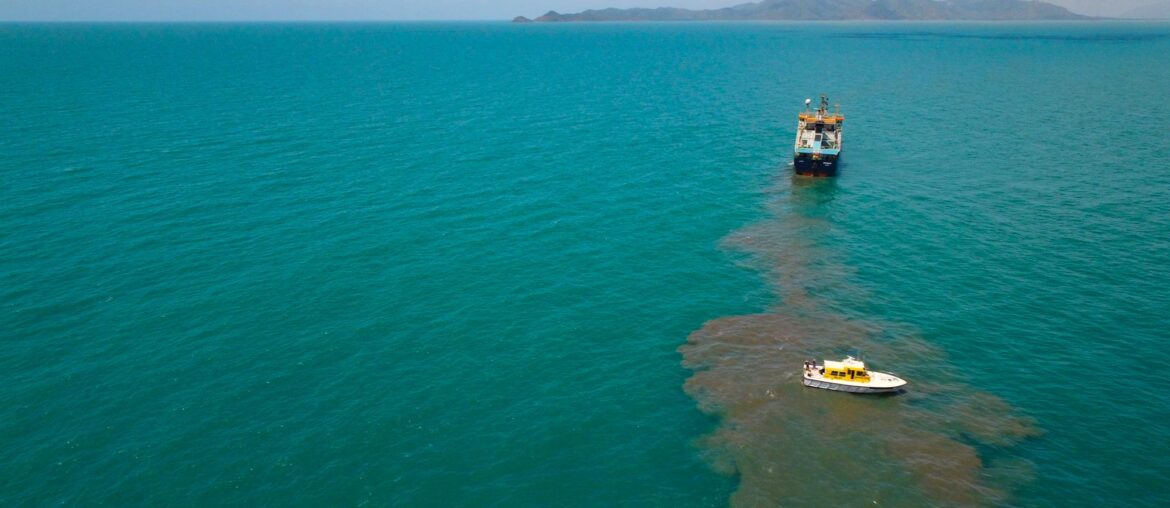It is well understood that landscape modification (dredging) alters the condition of ecosystems and the seafloor terrain, changing the three-dimensional topography and terrain of fish habitat. Although the impacts of species translocation, habitat fragmentation and habitat loss have been well researched, the ecological impacts of dredging activity in estuarine and shallow coastal environments are sparsely recorded. Some important estuarine fish impacted include; Australian bass, blue groper, black and yellowfin bream, sand and dusky flathead, mulloway (jewfish), Australian salmon, silver trevally, snapper, tailor, sand and yellowfin whiting, luderick, yellowtail kingfish and sea mullet.
What is dredging?
Dredging is a form of urbanisation of the environment to support the rapidly growing human population. It is the act of digging, gathering or removing sediment to deepen waterways in order to make way for harbours and channels. Sometimes dredging is conducted for environmental reasons to reduce the spread of pollutants contaminating the water that may be harmful to human and animal life.


What terrain helps fish thrive?
It is known that fish distribution, diversity and abundance is influenced by variation in the three-dimensional terrain in which they live. Terrain that features high relief, great complexity and/or morphological variation (mountains, canyons, ridges, etc.) are usually teeming with biodiverse forms of life, especially when they appear in landscapes and seascapes that are typically flat and featureless. Habitats like these provide refuge from predatory species, act as breeding spots and are usually abundant with food.
What are the impacts of dredging?
A 2022 study looked at the potential ecological impacts of dredging for estuarine and coastal fish species using seascapes in Eastern Australia as a model. Estuaries are extremely diverse ecosystems that offer habitat for many species and are structurally complex. Often consisting of components such as, mangroves, saltmarshes, sandbars, seagrasses, snags, rock and channels. Estuaries are also hot spots for human utility values, providing recreation activities and opportunities for coastal development.
Within the study, ten baited remote underwater video stations (BRUVS) were evenly spaced upstream of the estuary mouth to capture video surveillance in order to sample diverse marine fish. To investigate whether, or how, changes to seafloor terrain from dredging impacts fish assemblages, high-resolution (≤ 1 m−1) digital bathymetric models were created for each estuary using depth soundings from a multi-beam acoustic sounder. Sonar data was processed using software and surface metrics were applied to quantify structural variation in seafloor terrain. Using nine terrain metrics, the effects of terrain on fish assemblages in a diversity of marine seascapes were selected to describe variation in the: relief (average depth), morphology (aspect: northness and eastness; plan curvature; and profile curvature), complexity (rugosity and slope) and composition (backscatter: E1 roughness and E2 hardness) of seafloor terrain.

What were the outcomes?
The study found that dredging has substantially changed the terrain of modified estuaries which when compared with natural estuaries, were deeper, had steeper sides and were comprised of substrates with lower roughness. Both natural and dredged estuaries supported significantly different fish assemblies, with abundance and species richness higher in dredged sites but more species present in natural estuaries overall. The composition of fish assemblages in estuaries is closely linked to three-dimensional properties of the seafloor and demonstrates how dredging can dramatically reshape the ecological significance of terrain features. Diversity and abundance of harvested species showed a strong correlation with seafloor depth, plan curvature, roughness and slope, and were always highest in the shallow areas of estuaries, and adjacent to terrain features with convex sides. Changes to the roughness and steepness of modified estuaries from dredging altered the way fish assemblages use terrain features. In natural estuaries and seascapes, harvested fish abundance and diversity were highest in places with lower roughness and steeper slopes, whereas in dredged estuaries harvested fish abundance and diversity were highest in areas with higher roughness and gentler slopes.
What does this mean?
Coastal regions are one of the most modified landscapes and seascapes globally, leading to much degradation. The transformation of coastal areas results in declines in biodiversity and abundance in fish populations. Dredging directly alters the morphology and complexity of the seafloor with the explicit intention of removing rough terrain features, and this study provides the first empirical evidence that dredging fundamentally alters the ecological significance of three-dimensional terrain features in coastal seascapes. The results of the study have vital implications for urban planning and coastal management, informing the ecological significance of terrain variation for fish, and how removal and reprofiling of sediments can reshape habitat use in modified landscapes.
Takeaways
- Although dredged estuaries showed higher species richness and abundance, natural estuaries had a greater diversity of species overall.
- Dredging is ultimately bad for fish ecology, as it directly impacts their natural habitat for breeding and feeding.
- It is vital for urban planners and coastal managers to consider the significant impacts that modifying landscapes/seascapes has for fish populations.
What’s next?
The key challenge is to now identify the ecological and functional consequences of changes in the spatial characteristics of dredged environments, and whether the impacts of dredging and terrain differ between species size-classes and life-stages, and within nursery ecosystems.
Resources
Main photo: Dredging.
Source: Australian Institute of Marine Science.




